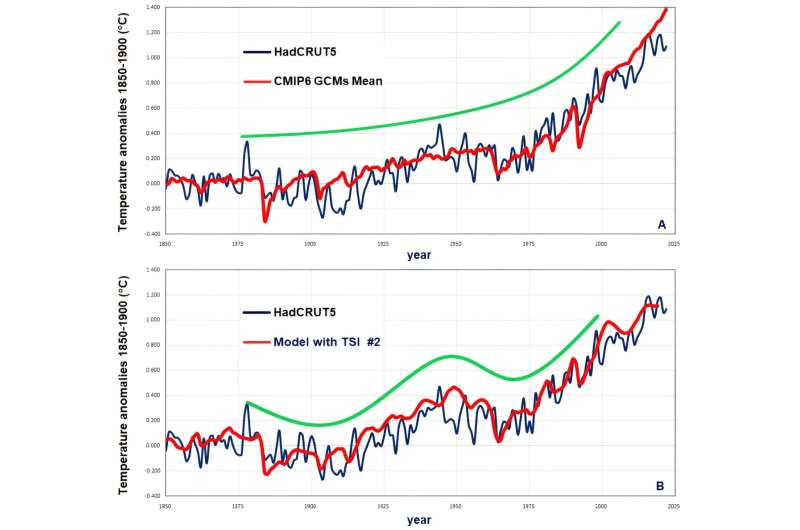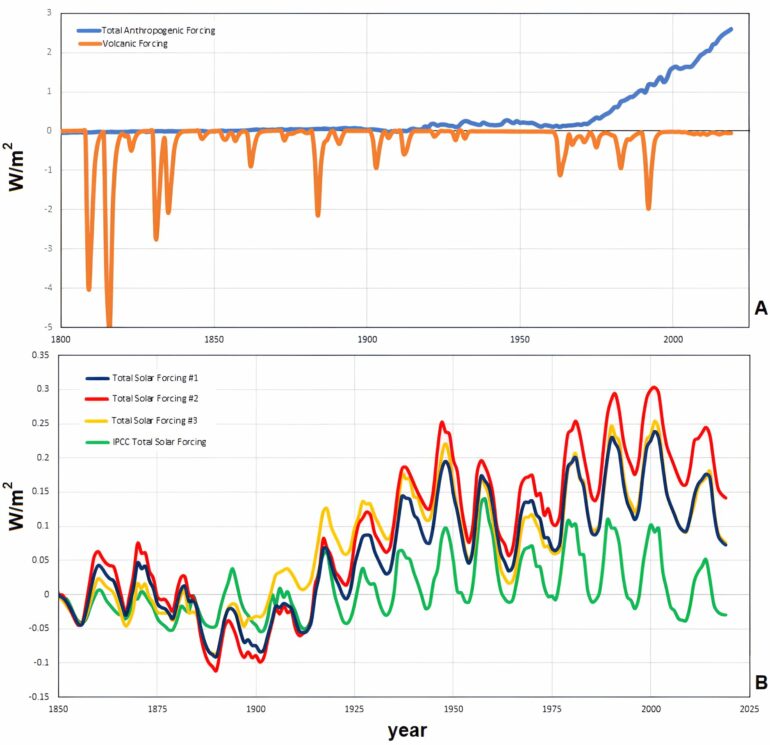Although the sun provides nearly all the energy needed to warm the planet, its contribution to climate change remains widely questioned. Many empirically based studies claim that it has a significant effect on climate, while others (often based on computer global climate simulations) claim that it has a small effect.
The Intergovernmental Panel on Climate Change (IPCC) supports the latter view and estimates that almost 100% of the observed warming of the Earth’s surface from 1850–1900 to 2020 was caused by man-made emissions. This is known as the anthropogenic global warming (AGWT) theory.
I addressed this important paradox in a new study published in Geoscience Frontiers. The conundrum appears to arise from two sets of uncertainties: (i) the historical decades and long-term variations in solar activity are unknown; (ii) the sun may affect Earth’s climate through various physical mechanisms many of which are not fully understood and do not exist in the GCMs.
It is important to notice that the AGWT is based solely on computer simulations of global climate models (GCMs) that use total solar irradiance (TSI) records with very low multidecadal and long-term variability. The same model also assumes that the sun affects the climate system only through radiative forcing such as TSI, although there is evidence that other solar processes may be related to solar magnetic activity (solar wind, cosmic rays, interplanetary dust, etc.) also affect the climate.
The total solar irradiance (TSI) records
Decadal and long-term changes in historical solar activity are unknown because total solar irradiance (TSI) reaching Earth can only be accurately measured by satellites, and these records have only been available since 1978. However, these data remain controversial, as different trends emerge depending on the combination and processing of records provided by different experimental teams.
Solar activity changes over longer periods are modeled using a number of solar activity proxies (e.g. sunspot records, faculae records, 14C and 10Be cosmogenic records, etc.). Proxy models are uncertain for definition, and the result is that the scientific literature has provided a variety of TSI reconstructions that greatly differ from each other in both their secular trends and multidecadal modulation.
I have combined several TSI proxy models, and I have evaluated their effective solar radiative forcing functions to be used for climate studies. Figure 1 compares them along with the volcano and anthropogenic effective forcings. The solar effective forcing functions depicted in Fig. 1B differ in several respects.
The solar forcing function currently used in the CMIP6 GCMs simulations (green) has remained nearly constant for about 200 years and, furthermore, it has decreased progressively from 1970 to 2020. Thus, by using this TSI record, the CMIP6 GCMs could only conclude that the sun could not explain almost any of the warming observed since the pre-industrial period (1850–1900), and particularly that observed from 1980 to 2020.
On the contrary, the other three TSI records (red, yellow, and black) reveal a multidecadal oscillation as well as a clear increasing secular trend that is closely correlated with the changes observed in total surface temperature records.

Figure 2. (A) HadCRUT5 global surface temperature versus the CMIP6 GCM ensemble average. (B) HadCRUT5 global surface temperature versus the proposed empirical modeling of the climate using the alternative solar model. © Geoscience Frontiers (2023). DOI: 10.1016/j.gsf.2023.101650
Modeling the total solar activity (TSA) change effect on the climate
The total sun’s effect on the climate cannot be assessed using only the TSI forcing functions because, for example, alternative solar-related mechanisms have been claimed to directly modulate cloud cover. However, because the physics of such mechanisms is still poorly understood, they cannot be implemented in current GCMs. However, if their impact is shown to be large, current GCMs will be unsuitable to model climate change.
I addressed this issue by assuming that the given TSI records are proxies for total solar activity (TSA) and I adopted an empirical methodology to assess the TSA effect by evaluating its optimal climate fingerprint together with those produced by the anthropogenic and volcanic radiative forcing functions adopted by the CMIP6 GCMs.
The model reproduces the results of the CMIP6 GCMs when their original forcing functions are applied under similar physical conditions. In this case, the equilibrium climate sensitivity (ECS) was 1.4°C–2.8°C, which is compatible with the low-ECS CMIP6 GCM group. This means that about two-thirds of the current GCMs (whose ECS varies between 1.8°C and 5.7°C) are overestimating anthropogenic warming, as other recent studies have confirmed.
However, if the proposed solar records are used as TSA proxies and the climatic sensitivity to them is allowed to differ from the climatic sensitivity to radiative forcings, a much greater solar impact on climate change is found, along with a significantly reduced radiative effect. In this case, the ECS is found to be 0.9°C–1.8°C, with a mean of around 1.3°C. This means that anthropogenic warming is greatly overestimated.
Fig. 2 compares the HadCRUT5 global surface temperature record to (A) the CMIP6 GCM ensemble mean record and (B) the energy balance model using a proposed TSA model that does not use the GCMs’ low-secular-variability TSI record. The GCM simulation depicted in Fig. 2A monotonically warms up (green sketch). On the contrary, the model provided in Fig. 2B indicates an oscillating pattern developing around a warming trend that reproduces the climatic record far more precisely.
This result suggests that about 80% of the solar influence on the climate may not be induced by TSI forcing alone, but rather by other sun-climate processes (e.g., by a solar magnetic modulation of cosmic ray and other particle fluxes, and/or others). These alternative mechanisms must be thoroughly investigated and physically understood before trustworthy GCMs can be created to correctly interpret climate change and produce reliable climate change projections for the future.
This story is part of Science X Dialog, where researchers can report findings from their published research articles. Visit this page for information about ScienceX Dialog and how to participate.
More information:
Nicola Scafetta, Empirical assessment of the role of the Sun in climate change using balanced multi-proxy solar records, Geoscience Frontiers (2023). DOI: 10.1016/j.gsf.2023.101650
Prof. Dr. Nicola Scafetta works in the Department of Earth Sciences, Environment and Georesources, University of Naples Federico II, Naples, Italy
Citation:
Understanding the role of the sun in climate change (2023, July 6)



